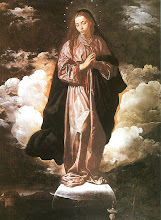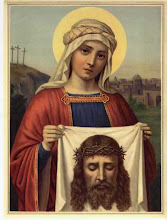I'm feeling quite convicted right now about veils and the act of veiling. I've tried it before on a few occasions and have my own veil, but I never bring it to my regular parish. I always wear it when I'm at other parishes. I'm not sure why. It's just easier for me I suppose. No one knows me. I guess I just believe no one really pays attention to me if I'm not a member of the parish. Then again, that's probably a little selfish and conceited to think that people are looking at me right? I should assume they are all focused on Our Lord, but in truth, some people's minds might be elsewhere.
In truth, I've avoided veiling for selfish and prideful reasons. Heathcliff used to bug me quite a bit about purchasing one and wearing one consistently to mass. As a result, I instinctively rebelled. I sometimes have a problem with people telling me what to do and when to do it, especially if it comes from a man. I guess there is still some residual feminist left in me, but it's usually not a problem unless someone demands I do something instead of politely asking. Moreover, I worry about people at church and what they think. "Oh, look, there's that uuber religious young chick," they might think in a derogatory tone. Or maybe, "she's just trying to look Holy, but I bet she's not. Weird traditionalist girl." But this is not being charitable towards other people's thoughts. I shouldn't think that they are thinking the worst about me. I would hope they would try to be more charitable towards me and what I'm thinking of them, such as, "oh, look how pretty that girl looks in her veil. So peaceful too, maybe I should start wearing one as well."
Something I read in the comments about this made me think about veiling and receiving communion on the tongue. "One thing that always amazes me is Catholics who are intimidated by receiving Holy Communion kneeling and on the tongue or women who want to wear a head covering but are concerned about the reaction from others. Is this the Church Militant whose history includes thousands of martyrs?"
This person has a point. How can I even be sure of myself, if Lord forbid, I was faced with the chance to be a martyr to be courageous enough to die for Our Lord if I can't even gather up enough guts to wear a piece of lace on my head for fear of looking silly or receive communion on the tongue for fear of bad breath? I can say that yes, I would die for Him, but logic stands to reason that since I can't even do these small things, what would I really do in a much more dire situation?
The irony of it all is that my patron Saint, Saint Veronica (pictured to your right) could be considered the patron saint of the veil-wearers! A quick refresher for those who need it: Saint Veronica is depicted in the sixth station of the cross. She is the woman who wipes Jesus' face with her veil. When He hands it back to her, He leaves His Holy Countenance on it. Tradition has it that Veronica went to great lengths to protect the veil and get it to St. Peter's. Her given name is unknown (it is speculated that it might be Bernice): she is named after the relic, the veil, the Holy Face or vera icon, the True Image. I picked her as my patron Saint because it was down to her or Saint Therese; Veronica seemed like she needed some love as no one really seems to know who she is. Everything the Church knows about her is through tradition. But I liked her for the same reason I liked Saint Therese - her legacy is based on a small action. For this reason (only tradition - no miracles), she does not have an official feast day on the church calendar, but when she was on it, it was July 12.
When you think about Veronica (or at least when I do), the first thing I associate her with is her veil. Like Mary is always directing us to Jesus, Veronica does the same. In pictures, her veil is always displayed for all to see the Holy Countenance. This is another reason why I picked her. The prayers imploring her for help often ask to the sight to see the face of Jesus in others. Moreover, what does it say about the veil that Jesus left His face on it? Obviously, He's given the veil His blessing since He impressed His likeness on it, not just as a blessing on Veronica for being charitable, but for all who follow in her footsteps in wearing the veil.
Veiling seems like the way to go, but it also seems that the veil calls a gal to buck up and put on a skirt and receive communion on the tongue. All I can ask for is the grace to do it. Saint Veronica, pray for me!
And now for the fun part, pictures!
An artist's interpretation of Veronica. Her face is blank, and I quite like that touch.
Saint Veronica bearing the veil at the Vatican. Doesn't this statue make you think she's a strong woman?
This is probably my favorite rendition of her, maybe even more liked than the traditional/ most used image (see to the right). She looks so determined and strong here, and yet, you still see Jesus' face. She looks like she's guarding it with her life.
Prayer to Saint Veronica
St. Veronica, you gave Christ a towel on His way to Cavalry
Which He used to wipe the Precious Blood from His Holy Face.
In return for this great act of kindness He left you His most Holy image on the towel.
Pray for us to Our Lord that His Holy Face may be imprinted
on our hearts so that we may be always be mindful of the Passion and Death
of Our lord Jesus Christ, through the same Christ our Lord,
Amen.
P.S. I'm cooking up a little veiling experiment. Look for it in a future (read: relatively soon) post.






